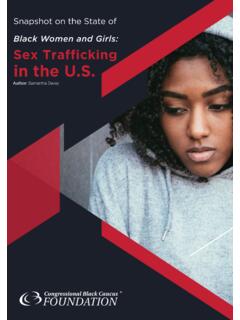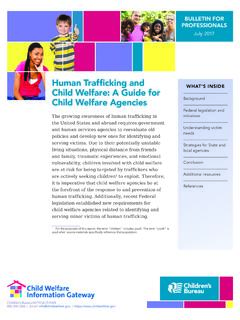Transcription of Mexico: Organized Crime and Drug Trafficking Organizations
1 Mexico: Organized Crime and Drug Trafficking Organizations Updated July 28, 2020 congressional research Service R41576 congressional research Service SUMMARY Mexico: Organized Crime and Drug Trafficking Organizations Mexican drug Trafficking Organizations (DTOs) pose the greatest Crime threat to the United States and have the greatest drug Trafficking influence, according to the Drug Enforcement Administration s (DEA s) annual National Drug Threat Assessment. These Organizations , often referred to as transnational criminal Organizations (TCOs), continue to diversify into crimes of extortion, human smuggling, and oil theft, among others.
2 Their supply chains traverse the Western Hemisphere and the globe. Their extensive violence since 2006 has caused Mexico s homicide rate to spike. They produce and traffic illicit drugs into the United States, including heroin, methamphetamine, marijuana, and synthetic opioids such as fentanyl, and they traffic South American cocaine. Mexican DTO activities significantly affect the security of both the United States and Mexico. As Mexico s DTOs expanded their control of the opioids market, overdoses rose sharply according to the Centers for Disease Control, setting a record in 2019 with more than 70% of overdose deaths involving opioids, including fentanyl.
3 Many analysts believe that Mexican DTOs role in the Trafficking and producing of opioids is continuing to expand. Evolution of Mexico s Criminal Environment Mexico s DTOs have been in constant flux, and yet they continue to wield extensive political and criminal power. In 2006, four DTOs were dominant: the Tijuana/Arellano F lix Organization (AFO), the Sinaloa Cartel, the Ju rez/Vicente Carillo Fuentes Organization (CFO), and the Gulf Cartel. Government operations to eliminate the cartel leadership increased instability among the groups while sparking greater violence.
4 Over the next dozen years, Mexico s large and comparatively more stable DTOs fragmented, creating at first seven major groups, and then nine, which are briefly described in this report. The DEA has identified those nine Organizations as Sinaloa, Los Zetas, Tijuana/AFO, Ju rez/CFO, Beltr n Leyva, Gulf, La Familia Michoacana, the Knights Templar, and Cartel Jalisco Nuevo Generaci n (CJNG). In mid-2019, the leader of the long-dominant Sinaloa Cartel, Joaqu n El Chapo Guzm n, was sentenced to life in a prison, further fracturing the once-hegemonic DTO. In December 2019, Genaro Garc a Luna, a former head of public security in the Felipe Calder n Administration (2006-2012), was arrested in the United States on charges he had taken enormous bribes from Sinaloa, further eroding public confidence in Mexican government efforts.
5 Since his inauguration in late 2018, Mexican President Andr s Manuel L pez Obrador has implemented what some analysts contend is an ad hoc approach to security that has achieved little sustained progress. Despite reform promises, the president has relied on a conventional policy of using the military and a military-led national guard to help suppress violence. The president has targeted oil theft that siphons away billions in government revenue annually. Recent Developments In 2019, Mexico s national public security system reported more than 34,500 homicides, setting another record in absolute homicides and the highest national homicide rate since Mexico has published this data.
6 In late 2019, several cartel fragments committed flagrant acts of violence, killing citizens in some instances. Some Members of Congress questioned a policy of returning Central American migrants and others to await asylum proceedings in border cities, such as Tijuana, because these cities have reported among the highest urban homicide rates in the world. The Trump Administration also raised concerns over whether Mexican Crime groups should be listed as terror Organizations . In June 2020, two high-level attacks on Mexican criminal justice authorities stunned Mexico, including an early morning assassination attempt targeting the capital s police chief, allegedly by the CJNG.
7 He survived the attack, but three others were killed in one of Mexico City s most affluent neighborhoods. The other was the murder of a Mexican federal judge in Colima who had ruled in significant Organized Crime cases, including extradition of the CJNG s top leader s son to the United States. For more background, see CRS Insight IN11205, Designating Mexican Drug Cartels as Foreign Terrorists: Policy Implications, CRS Report R45790, The Opioid Epidemic: Supply Control and Criminal Justice Policy Frequently Asked Questions, and CRS Report R42917, Mexico: Background and Relations.
8 R41576 July 28, 2020 June S. Beittel Analyst in Latin American Affairs Mexico: Organized Crime and Drug Trafficking Organizations congressional research Service Contents Introduction .. 1 congressional Concerns .. 4 Escalation of DTO-Related Homicide, Corruption, and Impunity .. 6 Corruption and Government Institutions .. 9 Criminal Landscape in Mexico .. 11 Illicit Drugs in Mexico and Components of Its Drug Supply Market .. 13 Evolution of the Major Drug Trafficking 16 Nine Major 16 Tijuana/Arellano F lix Organization .. 17 Sinaloa DTO .. 19 Ju rez/Carrillo Fuentes Organization.
9 20 Gulf DTO .. 21 Los Zetas .. 22 Beltr n Leyva Organization .. 24 La Familia 25 Knights Templar .. 26 C rtel Jalisco Nuevo Generaci n .. 27 Fragmentation, Competition, and Diversification .. 28 Outlook .. 29 Figures Figure 1. Map of Mexico .. 2 Figure 2. Stratfor Cartel Map by Region of Influence .. 5 Figure 3. Major Ports of Entry at the Border .. 9 Figure 4. Customs and Border Patrol Seizures of Fentanyl and Methamphetamine .. 15 Appendixes Appendix. Drug Trafficking in Mexico and Government Efforts to Combat the DTOs .. 31 Contacts Author Information.
10 34 Mexico: Organized Crime and Drug Trafficking Organizations congressional research Service 1 Introduction Mexico shares a nearly 2,000-mile border with the United States, and the two countries have historically close trade, cultural, and demographic ties. Mexico s stability is of critical importance to the United States, and the nature and intensity of violence in Mexico has been of particular concern to the Congress. Over the past decade, Congress has held numerous hearings addressing violence in Mexico, counternarcotics assistance, and border security issues.














